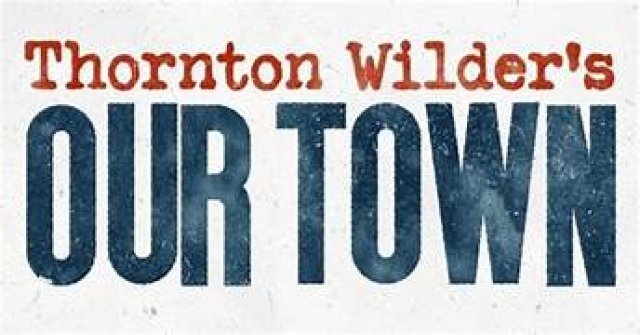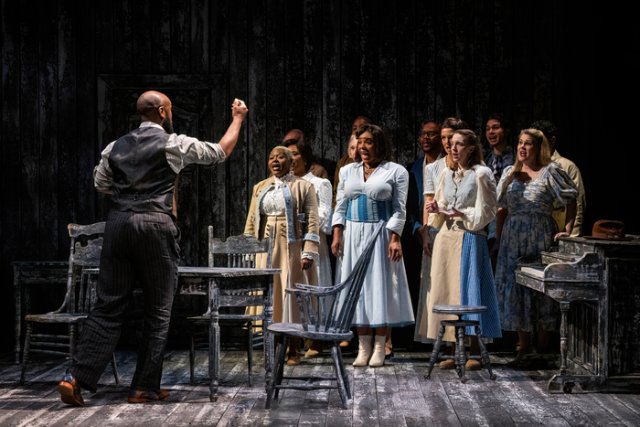Thornton Wilder's Our Town
Revival on Broadway
By: Karen Isaacs - Nov 10, 2024
Thornton Wilder’s classic play Our Town, which many consider it one of the great American plays – is getting a very good revival at the Ethel Barrymore Theatre on Broadway.
If you have never seen a production of the play, you may have been living in a cave; community theater groups and schools and colleges frequently produce it.
But in case you don’t remember, Our Town is Grover’s Corner, New Hampshire, at the beginning of the 20th century. We begin on a typical day on May 7, 1901(a baby is born); later, we see a wedding day on July 7, 1904, and finally, a funeral in 1913.
The beauty of Wilder’s play is that the events are so ordinary that we all can relate to them. The play also allows the director flexibility to mold the play. We often remember the play as sweet or sentimental reflecting an earlier “ideal” time. But it isn’t. While it may be staged either realistically or abstractly, the play is brutally realistic. Happy endings are for other plays. Our Town tells the truth about life: Death is always near.
I’ve seen productions with realistic scenery and props and those with almost bare stages; in period dress and in modern dress; emphasizing humor or emotions. All of these can work well.
We are guided on our journey to Grover’s Corner by a Stage Manager, who describes the settings and the people and who occasionally interrupts them to move the timeline along.
Jim Parson plays the role, and he is a delight. He eschews the common approach of being folksy or avuncular. Instead, he is more matter of fact and even, at times, irritated or frustrated as when a professor from a nearby college wants to go on and on about the geological features of the town.
This approach makes the production seem more modern. It also reduces the emotional tone of the play so that the third act is even more compelling.
Director Kenny Leon has stressed the universality of the play, by downplaying the sentimentality that is so often attached. This is no Hallmark film, but a realistic look at ordinary people and ordinary lives.
Among the elements that contribute to this modern feeling is the mixture of costumes – many of the performers are in modern dress including sneakers and tank tops. Even those dressed more formally would not be out of place today.
Leon has cast the play with a deft hand. The diversity of the cast may not have been the reality in Grover’s Corner, but it seems as though it should have been.
Two families are the central characters of the play — The Gibbs’ family – including Dr. Gibbs, Mrs. Gibbs, a son (George) and a daughter (Rebecca) are black – and the Webb family – Mr Webb (a newspaper editor), Mrs. Webb, daughter Emily and son Wally are white. They are neighbors and we quickly learn that George and Emily are sweet on each other, using an old-fashioned expression.
In some senses nothing much happens – we see Dr. Gibbs and Mr. Webb go to work, the mothers doing housework or going to choir practice, and the children returning from school and playing.
But under the surface so much is happening. Billy Eugene Jones and Richard Thomas portray the two men as kindly, thoughtful and loving – they could be ideal fathers. The mothers – Michelle Wilson and Katie Holmes have more circumscribed lives, but it is they who keep the families functioning.
If this was just a story of two families whose children fall in love, Our Town would be way less interesting. Wilder has subtly woven into the play other people and references to other lives. Dr. Gibbs refers to the settlement of Polish residents who live by the river, in what is obviously a less desirable part of town. Is there a slight implication of superiority? Perhaps.
In each act, cast members give memorable performances. I was drawn to the milkman, Howie Newsome, played terrifically by John McGinty. The fact that McGinty appears to be deaf, adds to production; this is a town that embraces all their residents. Julie Halston is hilarious as the resident who can’t stop repeating how lovely the wedding is, over and over. Then there is Simon Stimson (Donald Webber, Jr.), the organist whose worsening drinking problem is the subject of gossip. Yet no one ostracizes him.
As the young lovers, Ephraim Sykes’s George is so young, you wonder how anyone would think he should marry, while Zoey Deutch’s Emily seems more mature but not any readier for adulthood.
Leon has used scent in each of the scenes to trigger audience memories. I most noticed the bacon smell in act 3; I kept wondering where it came from. The scents in act 1 (heliotrope) and vanilla in act 2. The Beowulf Boritt scenic design is simple – with the appearance of a weathered barn, except for act 3. Justin Ellington’s sound design uses a wide selection of genres and periods. This fits right in with the costumes by Dede Ayite. The lighting design by Allen Lee Huges is essential to setting the moods of the play. The lanterns floating over the audience draw us into the world of Grover’s Corners.
The result is production that powerfully impels to think about our lives and our world. This production affected me more than most productions have. It reminded me what a truly exquisite play it is.
Our Town is at the Ethel Barrymore Theatre. It is running through Jan. 19.


